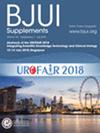Temporal trends and clinical determinants of urinary diversion after radical cystectomy.
IF 4.4
2区 医学
Q1 UROLOGY & NEPHROLOGY
引用次数: 0
Abstract
OBJECTIVES To evaluate the temporal trends in types of urinary diversion (UD) used after radical cystectomy (RC) in a large, multicentre, international cohort over the past two decades. MATERIALS AND METHODS We analysed 6469 patients who underwent RC between 2004 and 2024 at 23 international tertiary referral centres. Trends in UD type (cutaneous ureterostomy [UCS], ileal conduit [IC], and neobladder) were assessed using estimated annual percentage change (EAPC). Multivariable analysis (MVA) models identified preoperative predictors of UD type. EAPC was applied to evaluate temporal changes in the patient characteristics associated with UD type. RESULTS Overall, 882 (14%), 3611 (56%) and 1976 patients (31%) underwent UCS, IC, and neobladder procedures, respectively. IC remained the most common UD, without significant temporal change (P = 0.1). UCS use increased from 2% to 22% (EAPC 9.9%; P < 0.001), while neobladder use declined from 41% to 19% (EAPC -2%; P = 0.009). MVA showed that older age, comorbidities, and advanced disease were associated with higher rates of UCS and lower rates of neobladder use (all P < 0.005). Neoadjuvant chemotherapy (NAC) was inversely linked to UCS, while robot-assisted RC and male sex favoured neobladder use (all P < 0.005). EAPC showed rising proportions of male patients (EAPC 6.7%), patients aged >70 years (1.2%), patients with a Charlson Comorbidity Index ≥3 (8.3%), patients who received NAC (10.4%) and patients with cT2-cN0 disease (0.5%; all P < 0.05). CONCLUSION Over two decades, a marked increase in UCS use has been observed, alongside a decline in neobladder reconstruction. These trends coincided with a shift toward older, more comorbid patients undergoing RC. Evolving patient profiles and surgical practices underscore the need for tailored UD strategies and optimised peri-operative management.根治性膀胱切除术后尿转移的时间趋势和临床决定因素。
目的:在过去的20年里,在一个大型、多中心、国际队列研究中,评估根治性膀胱切除术(RC)后尿分流(UD)类型的时间趋势。材料和方法我们分析了2004年至2024年间在23个国际三级转诊中心接受RC的6469例患者。使用估计年百分比变化(EAPC)评估UD类型(皮肤输尿管造口术[UCS]、回肠导管[IC]和新膀胱)的趋势。多变量分析(MVA)模型确定了UD类型的术前预测因子。应用EAPC评估与UD类型相关的患者特征的颞部变化。结果总体而言,分别有882例(14%)、3611例(56%)和1976例(31%)患者接受了UCS、IC和新膀胱手术。IC仍然是最常见的UD,没有显著的时间变化(P = 0.1)。UCS的使用从2%增加到22% (EAPC 9.9%, P 70岁(1.2%),Charlson合病指数≥3的患者(8.3%),接受NAC的患者(10.4%)和cT2-cN0疾病的患者(0.5%),均P < 0.05)。结论:在过去的二十年中,观察到UCS的使用显著增加,同时新膀胱重建的数量下降。这些趋势与接受RC的老年、更多合并症患者的转变相吻合。不断发展的患者概况和外科实践强调了定制UD策略和优化围手术期管理的必要性。
本文章由计算机程序翻译,如有差异,请以英文原文为准。
求助全文
约1分钟内获得全文
求助全文
来源期刊

BJU International
医学-泌尿学与肾脏学
CiteScore
9.10
自引率
4.40%
发文量
262
审稿时长
1 months
期刊介绍:
BJUI is one of the most highly respected medical journals in the world, with a truly international range of published papers and appeal. Every issue gives invaluable practical information in the form of original articles, reviews, comments, surgical education articles, and translational science articles in the field of urology. BJUI employs topical sections, and is in full colour, making it easier to browse or search for something specific.
 求助内容:
求助内容: 应助结果提醒方式:
应助结果提醒方式:


